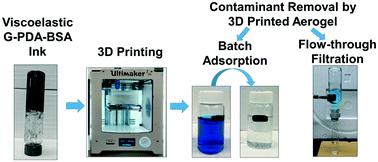当前位置:
X-MOL 学术
›
Environ. Sci.: Nano
›
论文详情
Our official English website, www.x-mol.net, welcomes your feedback! (Note: you will need to create a separate account there.)
Emerging investigator series: 3D printed graphene-biopolymer aerogels for water contaminant removal: a proof of concept
Environmental Science: Nano ( IF 7.3 ) Pub Date : 2020-12-9 , DOI: 10.1039/d0en00953a Arvid Masud 1, 2, 3, 4, 5 , Chi Zhou 3, 4, 5, 6 , Nirupam Aich 1, 2, 3, 4, 5
Environmental Science: Nano ( IF 7.3 ) Pub Date : 2020-12-9 , DOI: 10.1039/d0en00953a Arvid Masud 1, 2, 3, 4, 5 , Chi Zhou 3, 4, 5, 6 , Nirupam Aich 1, 2, 3, 4, 5
Affiliation

|
Graphene-based 3D macroscopic aerogels with their hierarchical porous structures and mechanical strength have been widely explored for removing contaminants from water. However, their large-scale manufacturing and application in various water treatment processes are limited by their scalability. In this study, we report a proof-of-concept direct ink writing (DIW) 3D printing technique and subsequent freeze-drying to prepare graphene-biopolymer aerogels for water treatment. To provide appropriate rheology for DIW printability, two bio-inspired polymers, polydopamine (PDA) and bovine serum albumin (BSA), were added to the graphene-based ink. The biopolymers also contributed to the contaminant removal capacity of the resultant graphene-polydopamine-bovine serum albumin (G-PDA-BSA) aerogel. The physicochemical properties of the aerogel were thoroughly characterized from the nano- to macroscale. The 3D printed aerogel exhibited excellent water contaminant removal performance for heavy metals (Cr(VI), Pb(II)), organic dyes (cationic methylene blue and anionic Evans blue), and organic solvents (n-hexane, n-heptane, and toluene) in batch adsorption studies. The electrostatic interaction dominated the removal of heavy metals and dyes while the hydrophobic interaction dominated the removal of organic solvents from water. Moreover, the aerogel showed superb regeneration and reuse potential. The aerogel removed 100% organic solvents over 10 cycles of regeneration and reuse; additionally, the removal efficiencies for methylene blue decreased by 2–20% after the third cycle. The fit-for-design 3D printed aerogel was also effectively used as a bottle-cap flow-through filter for dye removal. The potential and vision of the 3D printing approach for graphene-based water treatment presented here can be extended to other functional nanomaterials, can enable shape-specific applications of fit-for-purpose adsorbents/reactors and point-of-use filters, and can materialize the large-scale manufacturing of nano-enabled water treatment devices and technologies.
中文翻译:

新兴研究者系列:用于水污染物去除的3D打印石墨烯-生物聚合物气凝胶:概念验证
基于石墨烯的3D宏观气凝胶具有分层的多孔结构和机械强度,已被广泛地用于去除水中的污染物。然而,它们的大规模制造和在各种水处理过程中的应用受到其可扩展性的限制。在这项研究中,我们报告了一种概念验证的直接墨水书写(DIW)3D打印技术,并随后进行了冷冻干燥以制备用于水处理的石墨烯-生物聚合物气凝胶。为了为DIW可印刷性提供适当的流变性,将两种受生物启发的聚合物聚多巴胺(PDA)和牛血清白蛋白(BSA)添加到了基于石墨烯的墨水中。生物聚合物还有助于所得石墨烯-聚多巴胺-牛血清白蛋白(G-PDA-BSA)气凝胶的污染物去除能力。从纳米尺度到宏观尺度,对气凝胶的物理化学性质进行了全面表征。3D打印气凝胶对重金属(Cr(VI),铅(II)),有机染料(阳离子亚甲蓝和阴离子伊文思蓝),以及有机溶剂(Ñ己烷,Ñ-庚烷和甲苯)进行分批吸附研究。静电相互作用主导了重金属和染料的去除,而疏水相互作用主导了水中有机溶剂的去除。而且,气凝胶显示出极好的再生和再利用潜力。气凝胶在10个再生和再利用循环中去除了100%的有机溶剂。此外,第三次循环后,亚甲蓝的去除效率降低了2–20%。专门设计的3D打印气凝胶也有效地用作瓶盖流通式过滤器,用于去除染料。本文介绍的用于石墨烯基水处理的3D打印方法的潜力和远景可以扩展到其他功能纳米材料,可以实现形状适合特定用途的吸附剂/反应器和使用点过滤器的应用,
更新日期:2020-12-24
中文翻译:

新兴研究者系列:用于水污染物去除的3D打印石墨烯-生物聚合物气凝胶:概念验证
基于石墨烯的3D宏观气凝胶具有分层的多孔结构和机械强度,已被广泛地用于去除水中的污染物。然而,它们的大规模制造和在各种水处理过程中的应用受到其可扩展性的限制。在这项研究中,我们报告了一种概念验证的直接墨水书写(DIW)3D打印技术,并随后进行了冷冻干燥以制备用于水处理的石墨烯-生物聚合物气凝胶。为了为DIW可印刷性提供适当的流变性,将两种受生物启发的聚合物聚多巴胺(PDA)和牛血清白蛋白(BSA)添加到了基于石墨烯的墨水中。生物聚合物还有助于所得石墨烯-聚多巴胺-牛血清白蛋白(G-PDA-BSA)气凝胶的污染物去除能力。从纳米尺度到宏观尺度,对气凝胶的物理化学性质进行了全面表征。3D打印气凝胶对重金属(Cr(VI),铅(II)),有机染料(阳离子亚甲蓝和阴离子伊文思蓝),以及有机溶剂(Ñ己烷,Ñ-庚烷和甲苯)进行分批吸附研究。静电相互作用主导了重金属和染料的去除,而疏水相互作用主导了水中有机溶剂的去除。而且,气凝胶显示出极好的再生和再利用潜力。气凝胶在10个再生和再利用循环中去除了100%的有机溶剂。此外,第三次循环后,亚甲蓝的去除效率降低了2–20%。专门设计的3D打印气凝胶也有效地用作瓶盖流通式过滤器,用于去除染料。本文介绍的用于石墨烯基水处理的3D打印方法的潜力和远景可以扩展到其他功能纳米材料,可以实现形状适合特定用途的吸附剂/反应器和使用点过滤器的应用,



























 京公网安备 11010802027423号
京公网安备 11010802027423号